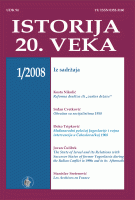BERZE U KRALjEVINI JUGOSLAVIJI
STOCK EXCHANGES IN THE KINGDOM OF YUGOSLAVIA
Author(s): Ivan M. BecićSubject(s): History
Published by: Institut za savremenu istoriju, Beograd
Keywords: stock exchanges; the Kingdom of Yugoslavia;
Summary/Abstract: A total of six stock exchanges existed in the Kingdom of Yugoslavia, but those in Belgrade, Zagreb and Ljubljana were setting the trends. Although all of them were of the mixed type, none had a particularly significant flow of merchandise. The remaining three – in Novi Sad, Sombor and Skoplje – traded exclusively in products, and among those Novi Sad exchange was dominant, except during a couple of years. As the capital and most important economical center of Serbia, Belgrade aimed to control if not the whole country’s economy, than at least its eastern part. Hence, an attempt was made to introduce agricultural products to the Belgrade stock exchange, but it failed and Vojvodina remained the center of this type of exchange with its two stock exchanges. As the center of the western part of the country, Zagreb used its position and financial supremacy, becoming the center of the trade in industrial securities and of the flow of hard currency, dominant over other parts of western Yugoslavia. Political and financial circles from Zagreb prevented Osijek, Split and Sušak from getting a permit to create their own stock exchanges and thus control the industries in these cities. Novi Sad was applying similar measures in preventing the forming of product stock exchanges, but not with equal success. It succeeded to prevent the creation of stock exchange in Veliki Bečkerek, but not in Sombor, which soon grew to be its rival in Vojvodina.
Journal: Istorija 20. veka
- Issue Year: 2008
- Issue No: 1
- Page Range: 27-41
- Page Count: 14
- Language: Serbian

